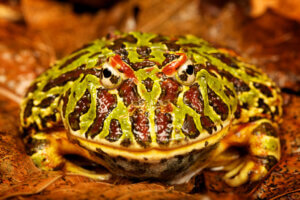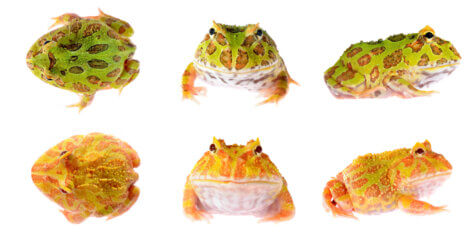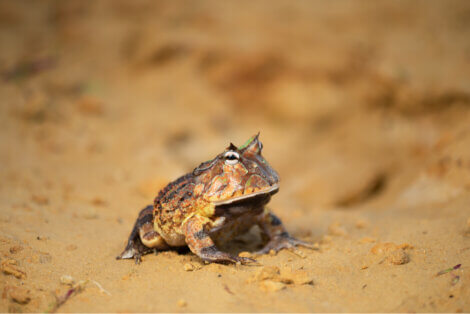Keeping a Pacman Frog as a Pet


Written and verified by the biologist Samuel Sanchez
Have you ever thought about having an exotic pet but been frightened of not being up to it? Are you passionate about amphibians but you don’t have any experience with them? If the answer to either of these questions is “yes”, then maybe you could get a Pacman frog. They’re the perfect pet for introducing yourself to the world of exotic animals.
Today, we’re going to introduce you to an amphibian with a stomach as big as its personality, and one of the most famous exotic pets there are. If you’ve ever thought about getting a Pacman frog, read on to find out everything you need to know!
Initial considerations
The term “Pacman frog” is used for a whole family of different frog species known as the genus ceratophrus. They can be found in Colombia, Brazil, Venezuela, and Argentina, amongst other regions, and are thus considered a tropical species.
In general, there are three different species available, although they all have the same requirements for their care.
- Ceratophrys cranwelli: This is the most common. This species is albino and is often seen in the windows of exotic pet shops.
- Ceratophrys ornata: This species is a little bit bigger. They’re green with more red tones when compared with the cranwelli.
- Ceratyphrys cornuta: This is very clearly different from the other two species since they have “horns” above their eyes.
There are no legal obstacles to keeping one of these animals since they’ve been bred in captivity for generations. So, you can be sure that adopting one won’t be supporting any illegal trade.

Keeping a Pacman frog
As we’ve already mentioned, this is a really easy pet to care for. However, there still certain requirements that you need to bear in mind before you get one.
First of all, there’s the terrarium. It should be about 20 inches long and have a width and height of about 12 inches. Although some Pacman frogs can reach 8 inches wide, they move so little that it’s unlikely to be a problem. There are three possible ways to set it up for them:
- A simple terrarium with just a bit of water: This isn’t recommended. It might be easier for you to clean, but it’s going to be a lot less pleasant for your frog.
- A couple of inches of bedding and a dish with some water: In this case, place a layer of coconut fibers or some other substrate that will retain the moisture. If your frog wants to refresh themselves, they can take a dip in the dish of water.
- Plants, rocks, recesses, and a naturalized environment: Whilst this might look prettier, it requires a lot of maintenance.
The temperature of the terrarium should oscillate between 75 and 85 degrees Centigrade (165-185 Fahrenheit), and you can do this by placing a heat blanket outside the terrarium, covering about a quarter of it. That way, your frog will have the choice of whether to sit in a warmer or cooler part of the terrarium.
Experts say that the relative humidity should be around 80-100%. You can achieve this by spraying the substrate with water at least twice a day. The bedding should always be moist to the touch but not soaking.
It’s really important to maintain the right humidity in the terrarium since amphibians perform gas exchange through their moist skin.
These frogs don’t swim well, so make sure their dish of water is not too deep.
An insatiable appetite
Without a doubt, the most fascinating thing about the Pacman frog is its appetite. These amphibians simply wait for their prey to pass in front of them, and it’s very unusual for them to actively go hunting.
As a general rule, it’s estimated that young ones should be fed every two days. Once they reach adulthood, this can increase to every 4 to 7 days. Their food should be coated in calcium powder and vitamins every 2 to 3 meals since these amphibians grow a lot and need various nutrients.
The Pacman frog will eat anything that moves and that it can fit in its mouth. In general, they won’t eat anything dead. Typical foods include mice, fish, other frogs of the same species, worms, cockroaches, crickets, and many others. However, the best diet is to feed them insects.
These frogs can suffer from intestinal problems due to their appetite, so it’s really important to watch how much you feed them.

As you can see, the Pacman frog makes a perfect pet if you’re looking to initiate yourself in the world of exotic pets. Nonetheless, there are specific requirements to consider, and you’ll need to take care of how much you feed them!
Have you ever thought about having an exotic pet but been frightened of not being up to it? Are you passionate about amphibians but you don’t have any experience with them? If the answer to either of these questions is “yes”, then maybe you could get a Pacman frog. They’re the perfect pet for introducing yourself to the world of exotic animals.
Today, we’re going to introduce you to an amphibian with a stomach as big as its personality, and one of the most famous exotic pets there are. If you’ve ever thought about getting a Pacman frog, read on to find out everything you need to know!
Initial considerations
The term “Pacman frog” is used for a whole family of different frog species known as the genus ceratophrus. They can be found in Colombia, Brazil, Venezuela, and Argentina, amongst other regions, and are thus considered a tropical species.
In general, there are three different species available, although they all have the same requirements for their care.
- Ceratophrys cranwelli: This is the most common. This species is albino and is often seen in the windows of exotic pet shops.
- Ceratophrys ornata: This species is a little bit bigger. They’re green with more red tones when compared with the cranwelli.
- Ceratyphrys cornuta: This is very clearly different from the other two species since they have “horns” above their eyes.
There are no legal obstacles to keeping one of these animals since they’ve been bred in captivity for generations. So, you can be sure that adopting one won’t be supporting any illegal trade.

Keeping a Pacman frog
As we’ve already mentioned, this is a really easy pet to care for. However, there still certain requirements that you need to bear in mind before you get one.
First of all, there’s the terrarium. It should be about 20 inches long and have a width and height of about 12 inches. Although some Pacman frogs can reach 8 inches wide, they move so little that it’s unlikely to be a problem. There are three possible ways to set it up for them:
- A simple terrarium with just a bit of water: This isn’t recommended. It might be easier for you to clean, but it’s going to be a lot less pleasant for your frog.
- A couple of inches of bedding and a dish with some water: In this case, place a layer of coconut fibers or some other substrate that will retain the moisture. If your frog wants to refresh themselves, they can take a dip in the dish of water.
- Plants, rocks, recesses, and a naturalized environment: Whilst this might look prettier, it requires a lot of maintenance.
The temperature of the terrarium should oscillate between 75 and 85 degrees Centigrade (165-185 Fahrenheit), and you can do this by placing a heat blanket outside the terrarium, covering about a quarter of it. That way, your frog will have the choice of whether to sit in a warmer or cooler part of the terrarium.
Experts say that the relative humidity should be around 80-100%. You can achieve this by spraying the substrate with water at least twice a day. The bedding should always be moist to the touch but not soaking.
It’s really important to maintain the right humidity in the terrarium since amphibians perform gas exchange through their moist skin.
These frogs don’t swim well, so make sure their dish of water is not too deep.
An insatiable appetite
Without a doubt, the most fascinating thing about the Pacman frog is its appetite. These amphibians simply wait for their prey to pass in front of them, and it’s very unusual for them to actively go hunting.
As a general rule, it’s estimated that young ones should be fed every two days. Once they reach adulthood, this can increase to every 4 to 7 days. Their food should be coated in calcium powder and vitamins every 2 to 3 meals since these amphibians grow a lot and need various nutrients.
The Pacman frog will eat anything that moves and that it can fit in its mouth. In general, they won’t eat anything dead. Typical foods include mice, fish, other frogs of the same species, worms, cockroaches, crickets, and many others. However, the best diet is to feed them insects.
These frogs can suffer from intestinal problems due to their appetite, so it’s really important to watch how much you feed them.

As you can see, the Pacman frog makes a perfect pet if you’re looking to initiate yourself in the world of exotic pets. Nonetheless, there are specific requirements to consider, and you’ll need to take care of how much you feed them!
All cited sources were thoroughly reviewed by our team to ensure their quality, reliability, currency, and validity. The bibliography of this article was considered reliable and of academic or scientific accuracy.
- Reptileguide, pacman frog care. Recogido a 26 de octubre en https://reptile.guide/pacman-frog-care/
This text is provided for informational purposes only and does not replace consultation with a professional. If in doubt, consult your specialist.








